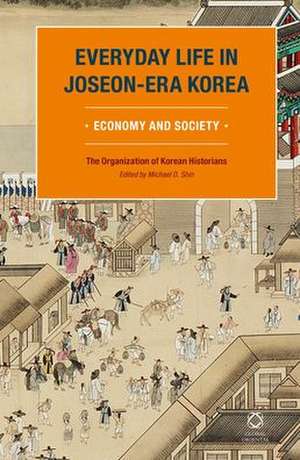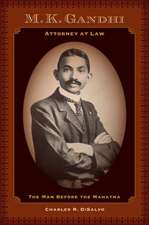Everyday Life in Joseon-Era Korea: Economy and Society
Autor The Organization of Korean Historians Michael D. Shinen Limba Engleză Hardback – 8 ian 2014
Everyday Life in Joseon-Era Korea shows how the momentous changes of the time transformed the lives of the common people. In twenty-three concise chapters, the book covers topics ranging from agriculture, commerce, and mining to education, marriage, and food culture. It examines how both the spread of Neo-Confucianism in the early Joseon period and its decline from the seventeenth century impacted economic and social life.
The book also demonstrates that much of what is thought of as ancient Korean tradition actually developed in the Joseon period. Chapters in this book discuss how customs such as ancestor worship, the use of genealogies, and foods such as kimchi all originated or became widespread in this era.
Contributors: Kim Kuentae, Yeom Jeong Sup, Kim Sung Woo, Lee Hun-Chang, Lee Uk, Yoo Pil Jo, Kim Kyung-ran, Kim Eui-Hwan, Oh Soo-chang, Ko Dong-Hwan, Kwon Nae-Hyun, Lee Hae Jun, Jung Jin Young, Kwon Ki-jung, Han Sang Kwon, Kwon Soon-Hyung, Jang Dong-Pyo, Seo-Tae-Won, Sim Jae-woo, Chung Yeon-sik, O Jong-rok, Hong Soon Min. This volume was co-translated by Edward Park and Michael D. Shin.
Preț: 885.99 lei
Preț vechi: 1080.48 lei
-18% Nou
Puncte Express: 1329
Preț estimativ în valută:
169.54€ • 177.37$ • 140.83£
169.54€ • 177.37$ • 140.83£
Carte disponibilă
Livrare economică 13-27 martie
Preluare comenzi: 021 569.72.76
Specificații
ISBN-13: 9789004261129
ISBN-10: 9004261125
Pagini: 296
Dimensiuni: 155 x 235 x 23 mm
Greutate: 0.61 kg
Editura: Brill
Colecția Brill
ISBN-10: 9004261125
Pagini: 296
Dimensiuni: 155 x 235 x 23 mm
Greutate: 0.61 kg
Editura: Brill
Colecția Brill
Notă biografică
Michael D. Shin, Ph.D. (2002), University of Chicago, is Lecturer in Korean Studies at the University of Cambridge. He has published research on early modern Korean history and is the co-editor of Landlords, Peasants, and Intellectuals in Modern Korea (Cornell East Asia Series, 2005).
Recenzii
Winner of the 2014 Choice Outstanding Academic Title Award
"Shin and Park have produced an eminently readable translation of a well-known and popular Korean-language history of Joseon-era Korea from 1996. How Did People Live in the Joseon Period? Shin's lively introduction provides an excellent overview of the Joseon era, which spanned from 1392 to 1910, offering readers sufficient historiographic background without getting bogged down by minutia. The subsequent chapters, rendered into fluid and engaging English, depart from the standard approach of more formal histories of Korea. Chapters cover topics as diverse as farming, currency, education, the penal system, the life and hard times of itinerant merchants, military life, food culture (including an interesting section on the origins of kimchi), and outhouses at the palaces. This focus on everyday life among the commoners interrupts earlier histories of Korea that focused largely on the ruling classes. The volume is beautifully illustrated and handsomely presented. A very helpful glossary and an excellent index complete the package. This book will be of considerable interest to students at the undergraduate levels (lower and upper division alike), and should find a spot on the bookshelves of general readers interested in the history of Korea." – T. R. Tangherlini, University of California, Los Angeles, in: CHOICE (July 2014) [Copyright American Library Assocation]
"Shin and Park have produced an eminently readable translation of a well-known and popular Korean-language history of Joseon-era Korea from 1996. How Did People Live in the Joseon Period? Shin's lively introduction provides an excellent overview of the Joseon era, which spanned from 1392 to 1910, offering readers sufficient historiographic background without getting bogged down by minutia. The subsequent chapters, rendered into fluid and engaging English, depart from the standard approach of more formal histories of Korea. Chapters cover topics as diverse as farming, currency, education, the penal system, the life and hard times of itinerant merchants, military life, food culture (including an interesting section on the origins of kimchi), and outhouses at the palaces. This focus on everyday life among the commoners interrupts earlier histories of Korea that focused largely on the ruling classes. The volume is beautifully illustrated and handsomely presented. A very helpful glossary and an excellent index complete the package. This book will be of considerable interest to students at the undergraduate levels (lower and upper division alike), and should find a spot on the bookshelves of general readers interested in the history of Korea." – T. R. Tangherlini, University of California, Los Angeles, in: CHOICE (July 2014) [Copyright American Library Assocation]













